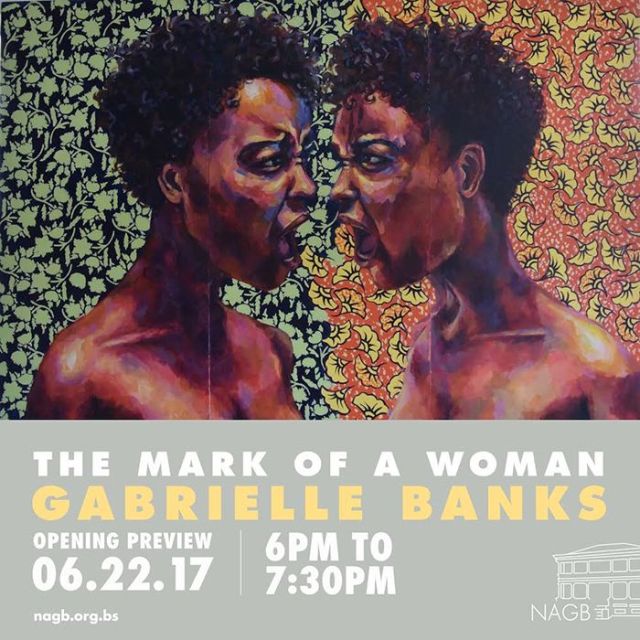 The National Art Gallery of Bahamas is in the city of Nassau on the island of New Providence in the Bahama Islands. The gallery is in a lovely old 1860’s mansion that had been the home of the first chief justice Doyle years ago before the Bahamas became independent within the Commonwealth of Nations in 1973. On the gentle hill overlooking the ocean and the clustered houses of the city, a mild summer breeze blows across the porches and porticos where a steady crowd gathered, streamed through, and stayed to converse about the stunning exhibition of paintings by Gabrielle Banks. (This is the view through the old glass of the west facing windows above one of the NAGB’s doors and then some scenes from the porches outside the reception).
The National Art Gallery of Bahamas is in the city of Nassau on the island of New Providence in the Bahama Islands. The gallery is in a lovely old 1860’s mansion that had been the home of the first chief justice Doyle years ago before the Bahamas became independent within the Commonwealth of Nations in 1973. On the gentle hill overlooking the ocean and the clustered houses of the city, a mild summer breeze blows across the porches and porticos where a steady crowd gathered, streamed through, and stayed to converse about the stunning exhibition of paintings by Gabrielle Banks. (This is the view through the old glass of the west facing windows above one of the NAGB’s doors and then some scenes from the porches outside the reception).

 In the center of the National Gallery (which is more like a museum as there are many rooms and two floors of galleries) is the project room, the gallery where Banks’ Mark of a Woman exhibition was installed. The show was curated by Holly Bynoe (Chief Curator) and assembled and hung by a host of people. Most of them were there at the reception, the artist’s mother and father, the staff of the National Gallery including its Board President Stan Burnside, its Secretary, sculptor and painter Antonius Roberts, Director Amanda Coulson, Richardo Barrett and Natalie Willis (assistant curators) and friends and family from various chapters of Gabrielle’s life including Michelle Pindling-Sands, Carla Lockhart, John Beadle (RISD 1989), and Michael Edwards (RISD 2000). I mention these people among many others as the sense of support, community, and mutual respect was palpable, powerful, and touching. Adding to the inspiration was a feeling of dignity, warmth, and love that was exceptional at this event, the opening night of Gabrielle Bank’s exhibition, her first in the Bahamas.
In the center of the National Gallery (which is more like a museum as there are many rooms and two floors of galleries) is the project room, the gallery where Banks’ Mark of a Woman exhibition was installed. The show was curated by Holly Bynoe (Chief Curator) and assembled and hung by a host of people. Most of them were there at the reception, the artist’s mother and father, the staff of the National Gallery including its Board President Stan Burnside, its Secretary, sculptor and painter Antonius Roberts, Director Amanda Coulson, Richardo Barrett and Natalie Willis (assistant curators) and friends and family from various chapters of Gabrielle’s life including Michelle Pindling-Sands, Carla Lockhart, John Beadle (RISD 1989), and Michael Edwards (RISD 2000). I mention these people among many others as the sense of support, community, and mutual respect was palpable, powerful, and touching. Adding to the inspiration was a feeling of dignity, warmth, and love that was exceptional at this event, the opening night of Gabrielle Bank’s exhibition, her first in the Bahamas.
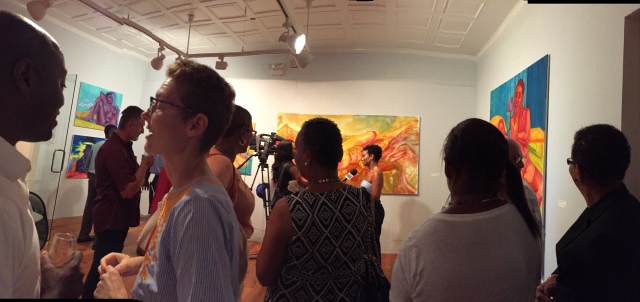
The crowd grew and in the background (of the photo above) is ZNS, the Bahamian television news station interviewing Gabrielle about her work. She said in the interview that aired on June 25th, 2017, “I experienced a lot of different experiences of being isolated, and being from the Bahamas, and also being a woman of color, specifically being a Black woman and a lot of the work explores kind of the struggles and the different experiences I had, feeling isolated, feeling kind of marginalized and put in a box with my identity, along with my explorations of color, and with me trying to progress, trying to become a better painter, and a lot of experimentations with color and with painting, just me generally being a student, so that’s mainly what the work is about.” And she notes that “…painting to me is part of who I am. It’s part of my existence.”
While many were there at the reception of her exhibition of paintings and have been there for her along the way, only one person does these paintings…one brush stroke, one shape, and one line at a time. And that would be Gabrielle (Gabby) Banks who this year has moved forward from an impasto Impressionist/Expressionist technique to a more luminous surface built up with chromatic glazes of oil medium. The work itself stood forth especially early in the reception when there was a chance to see the whole installation and to reflect with the artist and a few friends.


So here is a look at each painting in the show.
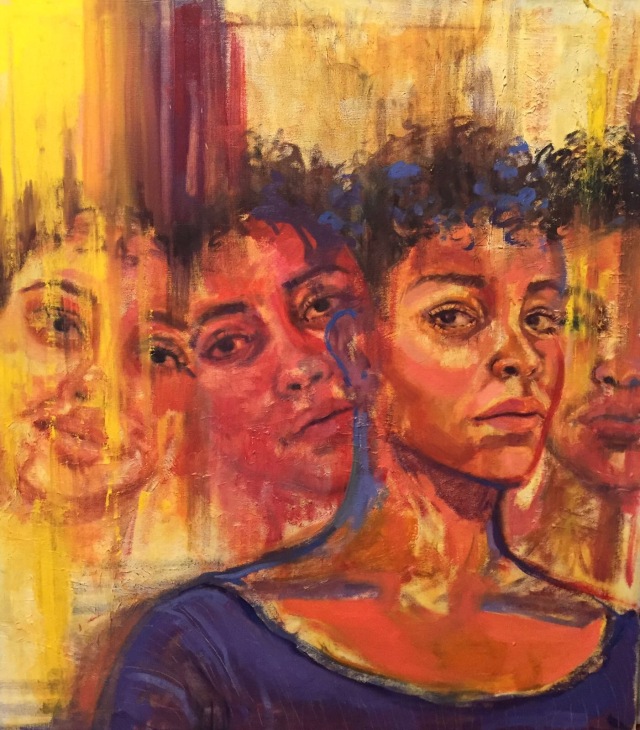
I liked the self portrait with the streaks of yellow and four portraits within the one. It is an introspective piece and seems to ask, “Who am I? What do I really think and feel? Who am I becoming and how do I shape what I am to be? How can I find the courage to be myself?”
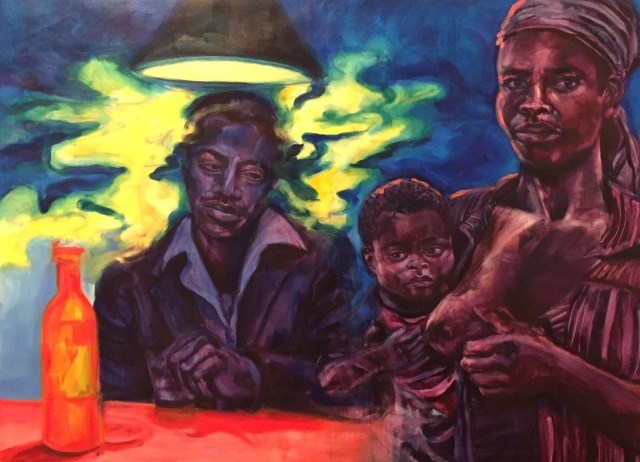
The family at the bar, or at the table under the lemon yellow light pulls at me. Each major shape has its own color. The man seems to be immersed in the yellow smoke or haze, a kind of force around him or coming from him. The psychology of the moment is compelling and brings to mind the work of the Le Nain brothers. In a color sense, it is a far cry from Le Nain, and more akin to Kirchner or Nolde.
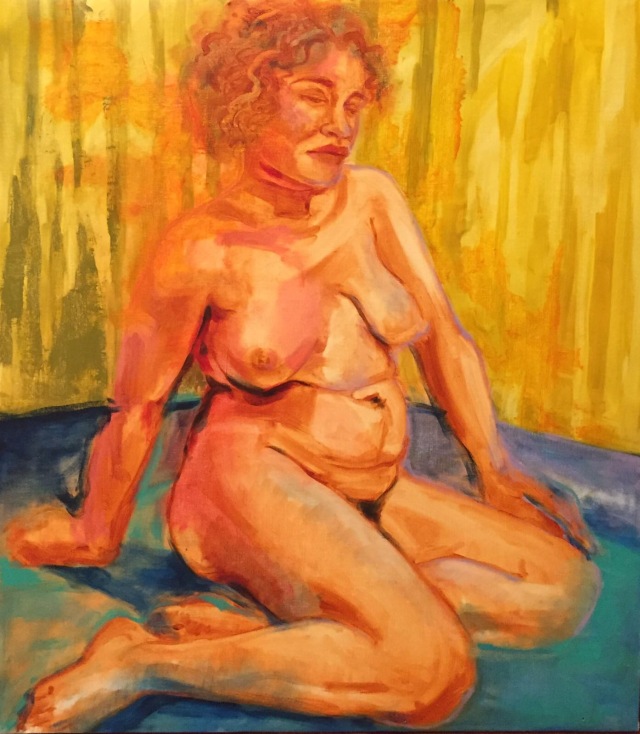
In the yellow nude, the color decisions are wonderful and I enjoy the shadows, lines, and and drawing highlights that move toward purple and how the local color is informed by the context, the reflected colors.

The reclining nude in a mountainous landscape is a fine bridge between the observed and the imagined. How she occupies the space is delightful. Gabby continues to draw with masterful confidence. (The facility and acumen of the work bring to mind Kerry James Marshall’s show, Mastry at Met Breuer, and the value of knowing the traditions of painting and where to utilize, depart from, or comment about them). Courbet comes to mind.

The magenta portrait (with two heads at lower left) is one of my favorites for the way it is composed and for the sense of narrative. The people feel specific. I like how the color changes from one zone to another and it makes me think of Chagall in this respect.
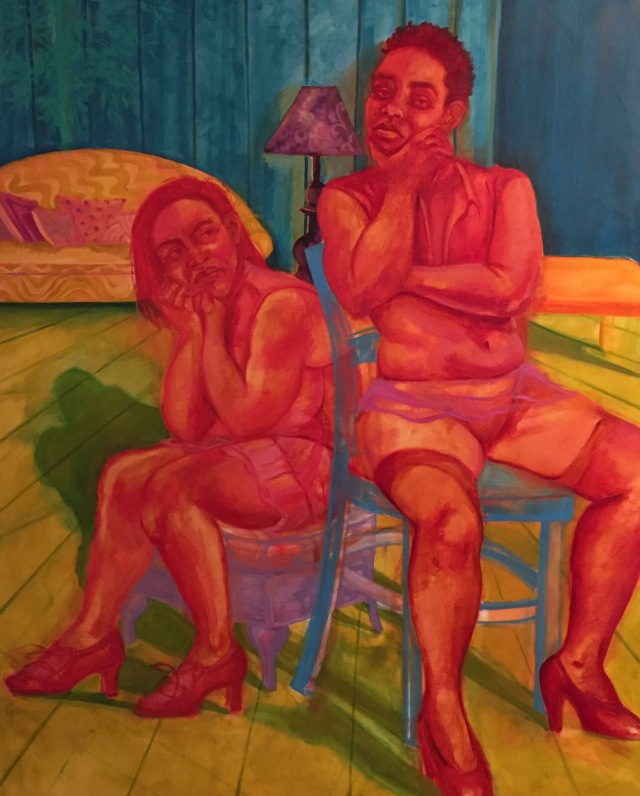
The double red nudes with high-heels, couch, purple lamp, and blue chair is sophisticated. It’s very difficult to make an invented painting like this with its intentional sense of gesture, proportion, and with its sense of the parts relating to the whole. The figures are over life size and the impact of this painting as seen in real life is visceral and powerful.

The purple nude in the tropical landscape is great. The sense of monumental scale and the particular color of the landscape (the aqua blue, the broken yellow tones), the cobalt blue range, and the solidity of the form are fully sculpted and beheld! The Goya Colossus comes to mind and too one of my favorite artists, Gauguin, though the figuration is more like Rodin with a touch of Maillol. These of course are just associations while the work has its distinct originality.
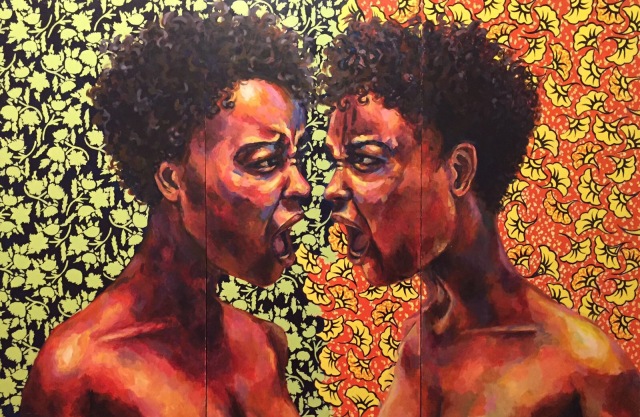
Then the Mark of the Woman is a hit of a painting, powerful, evocative, unforgettable in its screaming presence. I like how the pattern plays into the psychology of this painting, how each has its gestalt like words, symbols, or characters of what they are each saying (and I especially like the green and black floral modules and how they play against the reds, purples, and yellows of the figure).
All of this work is impressive indeed and Gabby is quite advanced in her work. She is a junior at Rhode Island School of Design but like Picasso, she is clearly a prodigy and we will likely be seeing a lot more from this gifted, hard-working, and gracious artist. This show at National Art Gallery of Bahamas is just a beginning.
After the reception, a small group of family and friends gathered at the Cafe Matisse.
It was Matisse who “discovered” African and Oceanic Art in 1906 (a few months before Picasso’s experience at the Ethnographic Museum of the Trocadero). Picasso brought the forms to full force in his Demoiselles d’Avignon of that same year. Matisse, on the other hand, in his visit six years later to Morocco, imbued his own painting with a personal sense of the chromatic light, flat color shapes of intense saturated color layered and effervescent. And later he let in the Islamic sense of pattern as experienced in textiles and architecture.
The story of the hybrid of French painting with West African Art is a fascinating one and is among the many topics Gabby and I discussed recently. Before she was a student at Miss Porter’s School from 2011-2015, Gabrielle already had in her paintings a beautiful sense of color and feeling for nature. At Porter’s, she took this further and began to balance invented and observed forms within a painting while building her skills through expressing her own subject matter as discovered via collage and later through portraits of friends and family.
After she graduated from Porter’s in 2015, I held an exhibition of African Art (during the following spring, March of 2016) of paintings belonging to Matti Dankor’s Dad, Saihou Saidy. The Saidy Collection (including work by Kizitomaria, Kamagwana, Gwoktcho, Ambrose, and others) was on exhibit in the Gilbert Gallery at Porter’s. The works are often highly hued, inventive, and figurative. I had been excited to curate this show as African Art leads to combining the African and French painting traditions as seen in Haitian painting. And during Gabby’s sophomore year, 2012, we had a show of Haitian painting in the Gilbert Gallery (that included Cassagnol, Disarms, Cauvin, Duffaut, Jose, Joseph, and Profil). My engagement with Haitian Art dates back to the late nineteen seventies when my brother Leland would go to Haiti with Smithsonian ethnomusicologist Dr. Tom Vennum in their study of the music in Voodou Ceremonies. Leland collected Haitian Art then, brought back canvases and postcards, and gave me a small painting by Baptiste (and I recently acquired one by Jonas Profil). Saidy’s collection features works by many amazing African painters. While Picasso had gone beyond the forms of African Art and deeply into their function (past the geometry and into the magic of how the object could function both as protector and vehicle for action), the Haitian painters continue with that particular Modernist sensibility and yet with a refreshing Folk Art feeling. The hybrid of French and African Art is a union of traditions of color and of form as well as a joining together of illusion, decoration, visual musicality, and empowerment.
At home in the Bahamas, Gabby grew up with the paintings of Amos Ferguson, Brent Malone, John Cox, and other Bahamian artists and with a sense of who they are and what they were doing in their paintings. In the sculptured courtyard and sacred spaces of the studio of Bahamian artist Antonius Roberts, she showed me an orchid wrapped in gauze to the bark of a palm tree and how the flower can grow there (as its roots fasten to the ruddy tree’s skin and drink the rain water that descends along its sides). Like the orchid, the tradition of French painting grafts onto the African Art legacy and grows into a marvelous art.
Gabby’s mother, Kelly Banks was born and raised in the Bahamas. She is a sophisticated computer expert initiating women’s leadership, previously the Americas Regional Technology Head at Citi Private Bank, and now working more independently. She has been a major driving force, advocate, and passionate supporter of her talented daughter. Like Gabby, she is deeply modest and recently said, “I’m really just a gardener at heart.” Gabby’s father, who is from the Lake District (home of Wordsworth and the Lake Poets) of north western England has a patient, sensitive, and quietly powerful sense about him. Early in his life, he apprenticed as a wood joiner and later became a quasi-engineer, architect, and currently oversees construction of mega-homes. He can design and build structures and some of that visual thinking and sequential clarity is traditionally in Gabby’s drawing and painting process.
A major influence on Gabrielle in this past year has been her RISD painting teacher Jennifer Packer who encouraged working in glazing layers of oil thinned paint and limiting her palette for more resonance among the selected colors. Other heroes include Paula Rego, Carrie Mae Weems, Alice Neel, and Paul Gauguin. In her Mark of a Woman show at the National Art Gallery of the Bahamas, most of the labels at the lower right of each painting said, “Untitled” and then in parentheses noted a mentor artist’s name or two. This I found to be remarkably humble as the works are influenced by but not appropriated from her mentor artists. For the many years I have known the artist, she has been amazingly humble and is so today.
Gabrielle continues to teach herself as she goes to see art in person (as was much emphasized in her Art History studies with Dr. Swinbourne at Miss Porter’s School) actual works of art; and on the internet she has found new soul-mates in painting such as painter Grace Weaver. While continuing to learn and grow, she shares her knowledge as she did years ago in the Glimpses of Morisot class at Porter’s (where she served as a mentor to the younger painters) and at RISD where again this summer and next year she will be a teacher’s assistant. She cultivates and participates in a dynamic circle of generosity and of authentic being, and has an innate sense of balancing her work and her life, all with a lot of beautiful color. As we say in our mission statement at Porter’s, she is “shaping a changing world”. In her ZNS interview on Bahamian TV, she encourages younger people to “keep doing what you love and good things will follow always.”
Grier, This is a wonderful piece! First off, i visited the museum in the Bahamas a couple years ago and you capture the place and ambiance perfectly. I am very very happy to learn about this young artist and see the work she is doing. Very strong and evocative. thanks for sharing.
LikeLiked by 1 person
I got what you intend, thankyou for posting.
LikeLike